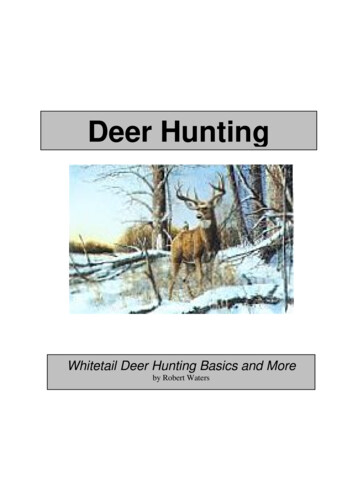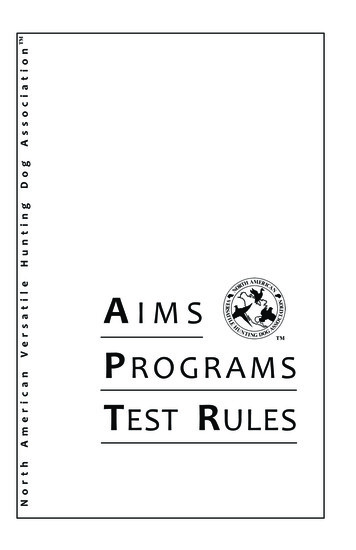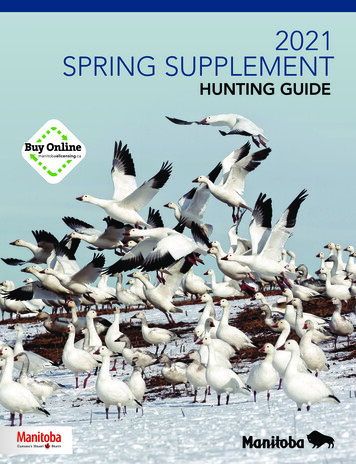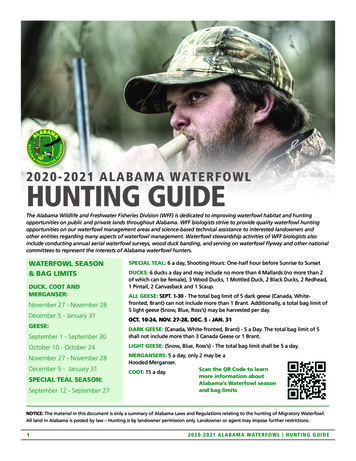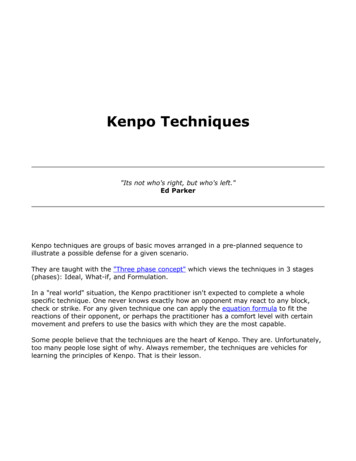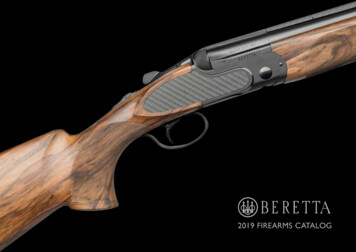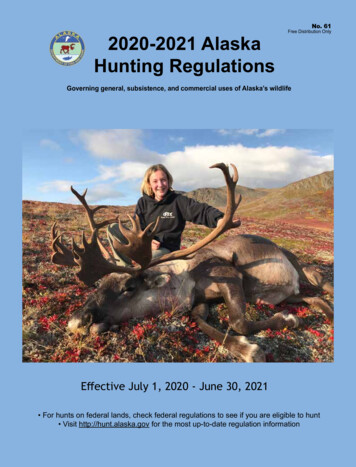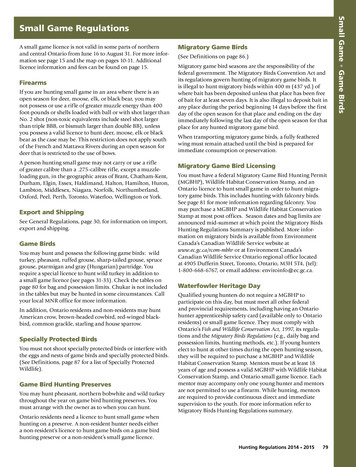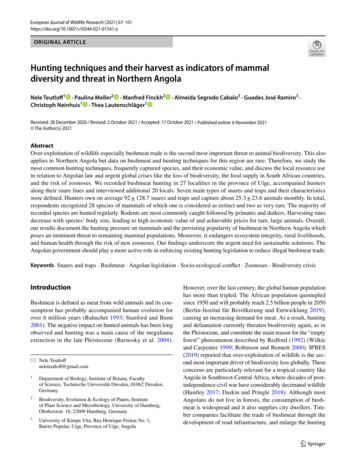
Transcription
European Journal of Wildlife Research (2021) 67: NAL ARTICLEHunting techniques and their harvest as indicators of mammaldiversity and threat in Northern AngolaNele Teutloff1 · Paulina Meller2 · Manfred Finckh2Christoph Neinhuis1 · Thea Lautenschläger1· Almeida Segredo Cabalo3 · Guedes José Ramiro3 ·Received: 28 December 2020 / Revised: 2 October 2021 / Accepted: 17 October 2021 / Published online: 6 November 2021 The Author(s) 2021AbstractOver-exploitation of wildlife especially bushmeat trade is the second most important threat to animal biodiversity. This alsoapplies to Northern Angola but data on bushmeat and hunting techniques for this region are rare. Therefore, we study themost common hunting techniques, frequently captured species, and their economic value, and discuss the local resource usein relation to Angolan law and urgent global crises like the loss of biodiversity, the food supply in South African countries,and the risk of zoonoses. We recorded bushmeat hunting in 27 localities in the province of Uíge, accompanied huntersalong their snare lines and interviewed additional 20 locals. Seven main types of snares and traps and their characteristicswere defined. Hunters own on average 92 128.7 snares and traps and capture about 25.3 23.6 animals monthly. In total,respondents recognized 28 species of mammals of which one is considered as extinct and two as very rare. The majority ofrecorded species are hunted regularly. Rodents are most commonly caught followed by primates and duikers. Harvesting ratesdecrease with species’ body size, leading to high economic value of and achievable prices for rare, large animals. Overall,our results document the hunting pressure on mammals and the persisting popularity of bushmeat in Northern Angola whichposes an imminent threat to remaining mammal populations. Moreover, it endangers ecosystem integrity, rural livelihoods,and human health through the risk of new zoonoses. Our findings underscore the urgent need for sustainable solutions. TheAngolan government should play a more active role in enforcing existing hunting legislation to reduce illegal bushmeat trade.Keywords Snares and traps · Bushmeat · Angolan legislation · Socio-ecological conflict · Zoonoses · Biodiversity crisisIntroductionBushmeat is defined as meat from wild animals and its consumption has probably accompanied human evolution forover 6 million years (Bahuchet 1993; Stanford and Bunn2001). The negative impact on hunted animals has been longobserved and hunting was a main cause of the megafaunaextinction in the late Pleistocene (Barnosky et al. 2004).* Nele Teutloffneleteutloff@gmail.com1Department of Biology, Institute of Botany, Facultyof Science, Technische Universität Dresden, 01062 Dresden,Germany2Biodiversity, Evolution & Ecology of Plants, Instituteof Plant Science and Microbiology, University of Hamburg,Ohnhorststr. 18, 22609 Hamburg, Germany3University of Kimpa Vita, Rua Henrique Freitas No. 1,Bairro Popular, Uíge, Province of Uíge, AngolaHowever, over the last century, the global human populationhas more than tripled. The African population quintupledsince 1950 and will probably reach 2.5 billion people in 2050(Berlin-Institut für Bevölkerung und Entwicklung 2019),causing an increasing demand for meat. As a result, huntingand defaunation currently threaten biodiversity again, as inthe Pleistocene, and constitute the main reason for the “emptyforest” phenomenon described by Redford (1992) (Wilkieand Carpenter 1999; Robinson and Bennett 2000). IPBES(2019) reported that over-exploitation of wildlife is the second most important driver of biodiversity loss globally. Theseconcerns are particularly relevant for a tropical country likeAngola in Southwest-Central Africa, where decades of postindependence civil war have considerably decimated wildlife(Huntley 2017; Daskin and Pringle 2018). Although mostAngolans do not live in forests, the consumption of bushmeat is widespread and it also supplies city dwellers. Timber companies facilitate the trade of bushmeat through thedevelopment of road infrastructure, and enlarge the hunting13Vol.:(0123456789)
101 Page 2 of 16European Journal of Wildlife Research (2021) 67: 101area by beating aisles far into the forest which enable accessto preserved areas (Laurance et al. 2006).The close contact to wild animals increases the riskofzoonoses, as the current outbreak of SARS-CoV-2 proves(Akhtar et al. 2020;Jacob et al. 2020; Tiwari et al. 2020).The largest outbreak of Marburg Fever ever reported globally caused 227victims in the Angolan province of Uíge in2004/05 (Ndayimirije and Kindhauser 2005). An ongoingoutbreak of Ebola fever in neighboringDRC has causedmore than 2200 victims so far. For lack of alternatives,many people in Angola rely onbushmeat for consumptionor as an economic income and thereby endangerthemselvesand the ecosystems they live in.Both, the increasing loss of biodiversity and the globalSARS-CoV-2 pandemic calls for a more complete pictureof hunting and its consequences. For this reason, researchin less described areas is essential. During previous studiesin the municipality of Uíge in Northern Angola, the sale ofbushmeat on markets and streets was often observed, suggesting that hunting is a widespread activity. Furthermore, snaresand traps, which are generally used by hunters, were foundoccasionally during fieldtrips. However, sustainable huntingis difficult to maintain. The province of Uíge’s population density of 24.3 persons/km2 (Censo 2014) significantly exceedsthe recommended sustainability threshold of 1 person/km2(Robinson and Bennett 2000). Furthermore, frequently huntedand endangered species like the White-bellied Pangolin existin the area, under threat by current practices (Kingdon 2015).Lastly, we assume a relationship between a higher huntingsuccess during specific seasons and habitat types, in whichsnares and traps are deployed.In order to address these hypotheses, we conducted interviews in rural areas of Uíge and gathered information abouthunting techniques and captured mammal species to assess (a)common hunting techniques, (b) hunted species, and (c) theireconomic value. Our general aim is to describe dimensions oflocal resource use which lie at the root of urgent global crisesagainst the background of the Angolan hunting legislation.Fig. 1 A Map of the study area province of Uíge with vegetationzones according to Barbosa (1970), locations of interviews markedin black dots, and Uíge city encircled in black. B Province of Uígelocated in Angola, C Location of Angola in Africa. Graphic: Copernicus Service Information 2019 (Buchhorn et al. 2020)13Materials and methodsStudy areaFrom February to April and from October to November2019, we conducted fieldtrips to 6 municipalities and 27localities in Angola’s Northern province of Uíge, where surveys were carried out. Research focused mainly on the prospective protected areas: Serra do Pingano, Serra Uíge, SerraCanacanjungo, and Mucaba. Additional studies took placein other municipalities throughout the province of Uíge.The province of Uíge borders in the north and east with theDemocratic Republic of the Congo, in the south with theprovinces of Malanje, Cuanza Norte, and Bengo, and in thewest with the province of Zaire (Fig. 1). It is divided in 16municipalities with a total area of 58,698 k m2 (Censo 2014).
European Journal of Wildlife Research (2021) 67: 101The geomorphology of Uíge is described in detail byHuntley et al. (2019): Uíge is divided into the EscarpmentZone to the west, and the Congo Peneplain to the east. TheEscarpment Zone is a hilly transition zone between thecoastal zone and interior plateaus and has characteristicmountain chains (Serras). These mountain chains dominatethe south west of Uíge city, the area where most data werecollected, with altitudes up to 1200 m and annual precipitation between 1300 and 1600 mm (Lautenschläger and Neinhuis 2014, 2020). The sandy Congo Peneplain is shaped bymany northwards flowing rivers, tributaries of the CongoBasin.The climate is a tropical wet or dry savannah climate (Aw)based on the Köppen climate classification, and includes arainy season in the hot wet summer from October to April,with a relative air humidity of 85–90% (Peel et al. 2007;Lautenschläger and Neinhuis 2014; Huntley et al. 2019).The winter is cool and dry with temperatures around 20 C,lasting from June until September (Huntley et al. 2019).Angola contains a larger range of biomes, seven out ofnine, than any other African country (White 1983; Huntleyet al. 2019) and encompasses 15 ecoregions (Olson et al.2001). The province of Uíge is described by White (1983)as a transition zone between the drier peripheral semievergreen Guineo-Congolian rain forest, the Zambeziandry evergreen forest, and transition woodland. Accordingto the more recent classification of ecoregions by Burgesset al. (2004), also used by the World Wildlife Fund (WWF)(Dinerstein et al. 2017), the province of Uíge belongs to theecoregion ‘Western Congolian Forest-Savannah Mosaic’, amixture of tropical and subtropical grasslands, savannahs,shrublands and woodlands (Olson et al. 2001; Burgess et al.2004).MethodsDue to the large size and to difficulties in accessibility ofthe area under research, the methods mainly concentratedon interviews with local hunters and public market surveys.During fieldwork, Portuguese language was mainly used.However, in some cases, Angolan colleagues translatedto the local language Kikongo. Gender and age of everyrespondent was documented wherever possible and localities of interviews were georeferenced. For all fieldtrips, theUniversity Kimpa Vita formulated in advance credentialsto inform the mayors of the municipalities about plannedresearch activities. To establish contact with potentialrespondents, local authorities of the visited villages (sobaand seculo) were informed about the aims and methods ofthe study and asked to suggest persons with experience inhunting that might participate. Methods were based on thetechniques developed by Noss (1998a) to answer our centralquestion on:Page 3 of 16 101a) Hunting techniques: We observed snare hunters andaccompanied 23 hunters along their snare lines. Werecorded different types of snares and traps, and hunterswere asked about their function, characteristics, numberof snares, control frequency, capture rate, and the speciesof captured animals. Further documented information wasthe time of construction: the actual time needed in thefield to either build a snare/trap if self-made or activate itif bought; durability: the time the snare/trap is active inthe field before it has to be rebuild; and how the knowledge of constructing snares was passed on. Additionally,hunters stated the location of their snares (savannah, forestor in both habitats equally) and the most profitable season(dry or rainy season, or whether hunting success is independent of the season). Detected snares and traps wereclassified according to types found in literature: SpringLoaded Bar Mousetrap, Simple Cable Snares, two typesof Foot-Snares, Spring-Spear-Traps, Deadfall Trap andSteel-Leghold Trap (Bateman 1989; Noss 1998b; Proulx1999; Burr 2015). Additional information was gatheredfor fishing rods and bird nets. However, we noted variation in snare types and hunting behaviors across distantregions, as a result of adaption to different environmentalconditions, the influence of personal skill, and local traditions. Thus, some snares and traps may vary from originaldescriptions recorded in the literature and were assignedto the most similar type.b) Species specific information: We performed interviewswith 15 of the 23 accompanied hunters and additional 20locals by showing pictures of animal species which possibly occur in the region (Kingdon 2015). The respondents were asked about abundance, harvesting rate, localname and economic value of the species. Not all of the20 locals were still hunting actively, they also includedvillage elders. The economic value of the species wasdocumented in local currency (AOA) between Octoberand November 2019. Because of the strongly fluctuatingexchange rate, we applied a standardized average of 1 430 AOA for our analysis. The number of respondents per interview varies as many were interviewed ingroups.Regulations for hunting and Angolan law: Huntingis only allowed during the hunting season (1st August – 31st December) with a hunting licence and only for thefollowing reasons: local subsistence (nutrition, clothing,medicine and culture), necessity (control of populationgrowth, protection of goods or self-defence), sports, andscientific research. An additional licence by the IDF(Instituto de Desenvolvimento Florestal) is needed forselling products (Ministério de Ultramar 1955; Ministério da Agricultura do Desenvolvimento Rural e dasPescas 1957; Ministério do Ensino Superior 2017). TheCombined Executive Decree No. 37/99 contains a pre-13
101 Page 4 of 16European Journal of Wildlife Research (2021) 67: 101sent list of animals whose hunting is prohibited (AnnexI) or whose hunting is allowed in specific seasons(Annex II) (Ministry of Agriculture and Rural Development 1999; Jones 2008; Mauck 2013). The additional Yellow List of Angolan Species (LEA) categorizesspecies according to their status of abundance or threatof extinction (Ministério do Ambiente 2018a). Furthermore, Angola is part of CITES (Convention on International Trade in Endangered Species of Wild Faunaand Flora). Appendix I of CITES lists species that arethreatened by extinction. CITES prohibits internationaltrade of these species, except when the purpose of theimport is not commercial (CITES 2019).c) Economic value of captured species: Complementaryto field trips, public market surveys were conducted atthe principal market in Uíge city, so as to record tradedanimals and their market value. In addition, sellers wereshown on printed images other species, and were askedwhich ones they usually sell and at which price. This information was complemented by own observations duringTable 1 Commonly used snare and trap types classified in typesfound in the literature (Bateman 1989; Noss 1998b; Proulx 1999;Burr 2015): average number of snares per hunter for every snare type,average control frequency of snare lines, average of the monthly harvest rate, average distance to the belonging village (in minutes byfoot), average time required for construction/deployment, and aver-A) Hunting techniquesage durability of snare and trap types. All values with their respectivestandard deviation. Further information shows the profitable seasons(R rainy season, D dry season, I independent), preferred location (Fforest, S savannah, C field, R river, Ca caves), and regions of detectedoccurrence (N Negage, M Mucaba, MZ Maquela do Zombo, SP Serrado Pingano, K Kimbele, A Ambuila)Location Distanceto village[in min byfoot]19.0 10.6 D, IN, MF, S, C2.0 1.112.4 8.7R, D, IN, SP, MZ, F, S, RK, A29.0 14.42.5 1.34.0 3.0R, D40.5 10.22.4 1.38.5 6.0R, D, I30 03.5 1.011.5 12.81.6 0.810.4 6.1R, I, D2.6 0.62.5 1.55.0 4.2R, D, I1 02.3 0.698xdayRSP, N, MZ, RK35.5 21.42.3 1.125xnight9.6 7.3RSPAveragenumber ofsnares perhunterControlfrequency[every usetrapSimpleCableSnaresFoot-Snare:Model 1Foot-Snare:Model ngRod orBarrierBird NetsOn average27.5 7.7Daily 079.9 13.613ResultsRegionSnarestypesProfitableseasonand between field trips. Identification of recorded animalsand data analysis were completed in Dresden, Germany.Collected information is based on respondent’s statements, which must be evaluated with care. Recording ofprivate hunting is not common because people mostlyhunt illegally and without licences. As a result, manyof the hunters interviewed responded reluctantly. Furthermore, secondary education in rural regions is rare,resulting in difficulties for most respondents in makingcareful assessments regarding time and numbers, such asfrequency of harvest. Finally, it is important to note thathunting behavior is performed at irregular time intervals,as many hunters also work in agriculture. Thus, theirstatements can only approximate reality.R, DTime forconstruction/deploymentDurability1.0 0.0 min 1 year27.0 13.57.3 3.1 min6.3 0.4 monthsN, SP, MZ, F, SAN, SP, M,F, SK, MZN, SpF, S43.1 33.651.6 59.0 minSP, M, K,ASP, N, MF, S23.4 10.4 564 432 min16.0 6.9 monthsF, C, S10.0 05.7 4.0 min 15 years30 02.0 0.0 hF, B, Ca27.0 198.3 2.9 min11.3 11.0 months4.4 5.8 months15.0 0.0 min26.7 20.4
European Journal of Wildlife Research (2021) 67: 101Table 2 Description of Fig. 2 illustrated snare and trap types withtheir mechanisms, material, and captured species: 1: Graphiurus sp.,2: Lophuromys sp., 3: Hylomyscus sp., 4: Grammomys sp., 5: Funisciurus pyrropus, 6: Thryonomys swinderianus, 7: Protoxerus stangeri,8: Atherurus africanus, 9: Anomalurus sp., 10: Cercopithecus ascanius ssp., 11: Miopithecus talapoin, 12: Colobus angolensis, 13:Philantomba monticola, 14: Sylvicapra grimmia, 15: CephalophusPage 5 of 16 101silvicultor, 16: Phataginus tricuspis, 17: Potamochoerus sp., 18: Genetta sp., 19: Mungos Mungo, 20: Bdeogale nigripes, 21: Crossarchusansorgei, 22: Tragelaphus scriptus, 23: Potamogale velox, 24: Syncerus caffer nano, 25: Loxodonta cyclotis, 26: Hypsignathus monstrosus, 27: Rousettus aegypticus, 28: Myonycteris angolensis, 29:Micropteropus pusillusA: Spring-Loaded Bar Mousetrap:The mechanism works with a spring-loaded bar (1) and a trip (2) to release it. The spring-loaded bar swings around rapidly with great impactwhen an animal, usually a mouse, touches the trip. By the force of the bar the mouses’ neck breaks. The trip can contain a bait (Ba) likemaniocMaterial: wood, metal, baitCaptured animal species: 1, 2,3,4, 7, 9Cable SnaresB: Simple Cable Snares:An open cable noose, vertical and above the ground is fixed to a branch (B) or similar. By entering, the cable noose tightens and closes aroundthe neck of the animal. The cable noose can be set up in different sizes depending on the hunted animal speciesMaterial: cord (bought or self-made of natural fibers), nylon, branchesCaptured animal species: 1, 2, 3, 4, 5, 6, 7, 8, 9, 10, 11, 13, 14, 15, 16, 17, 18, 19, 20, 21, 22, 23, 24, 28, 29C: Foot-Snare Model 1:A small hole (H) is covered with a platform of bark, small sticks and leaves which acts as a trigger mechanism. A cable noose encircles the edgeof the hole and is attached to a bent-over branch (B). When an animal steps on the platform (1) stick 1 gets released (2). The branch springs up(3) and tighten the cable noose around the leg of the animal (4)Material: cord, branchesCaptured animal species: 1, 2, 3, 4, 5, 6, 7, 8, 9, 10, 11, 13, 14, 15, 16, 17, 18, 19, 20, 21, 22, 23, 24D: Foot-Snares Model 2:Water in which fishes were gutted serves as a bait (Ba) by filling it into a hole in front of the snare. When the animal steps in the snare on stick 1,the trigger mechanism and stick 2 get released. The bent-over branch (B) pulls backward and tighten the cable noose around the animals’ limb.There is a variation of this model designed for birds where the trigger mechanism gets activated when a bird touches stick 1 with the intentionof finding a place to sitMaterial: baits (manioc, mice, fishwater), cord, branchesCaptured animal species: 1, 2, 3, 4, 5, 6, 7, 8, 9, 10, 11, 13, 14, 16, 17, 18, 19, 20, 21, 22E: Spring-Spear-Traps:A spear (1) attached to a bent branch (B) impales whatever is in its path when the trigger in form of a stretched cord (2) is activatedMaterial: cord, branchesCaptured animal species: 1, 2, 3, 4, 5, 6, 7, 9, 13, 14, 16, 18, 19, 20, 21, 22F: Deadfall Trap:A platform of branches carrying stones hangs on two bent-over branches (B) which are attached to a cord. The cord connects the branches witha little stick 1 clamped between the platform and a stick 2, which touches the ground. A bait (Ba) under the platform like manioc or fishwaterattracts animals and by searching for food they move stick 2 what releases stick 1. The two branches spring backward and the platform fallsdown onto the animalMaterial: Trunks, branches, cord, stones, baitCaptured animal species: 1, 2, 3, 4, 5, 6, 7, 9, 10, 11, 13, 16, 18, 19, 20, 21G: Steel-Leghold Trap:Steel-Traps are made of metal and were first imported to Africa by colonists from Europe to hunt large predators while exploiting tropical countries in the late eighteenth century (Bateman 1989). The trap consists of two jaws opened to 180 at set position and each closes 90 upon eachother when an animal steps on the trapMaterial: Steel, sometimes with additional branchesCaptured animal species: 1, 2, 3, 4, 5, 6, 7, 8, 9, 10, 11, 13, 14, 16, 17, 18, 19, 20, 21, 22We detected seven main types of snares and traps(Tables 1 and 2, Fig. 2, Online Resource Fig. S1) ofwhich most are nonselective. Some types, however, suchas the spring-loaded bar mousetrap target specific species. Specific baits as manioc or mice attract differentfeeding guilds like herbivores or carnivores. Althoughfishing rods or barriers, and bird nets are not specificallymade to hunt mammals, bats enter nets and otter-shrewsrods, accidentally. As they are not set up daily and do not13
101 Page 6 of 16European Journal of Wildlife Research (2021) 67: 101Fig. 2 Drawings of observedsnare and trap types withtheir main characteristics. ASpring-Loaded Bar Mousetrap,B Simple Cable Snare, C FootSnare Model 1, D Foot-SnareModel 2, E Spring-Spear Trap,F Deadfall Trap, G SteelLeghold Trap. Functions aredescribed in Table 1have a permanent intake, they are mentioned in Table 1but excluded from the average harvesting rate.The simple cable snare is the most used snare with onaverage 80.0 13.6 activated exemplars in the field at atime per hunter. The trap type with the highest capturerate was the spring-loaded bar mousetrap with a meansuccess rate of 19.0 10.6 animals per month. The knowledge necessary for constructing self-made snares andtraps is mostly passed on from previous generations. Only3 hunters (13%) learnt through observations from friendsor unknown people. Regarding the construction/ deployment time, it is important to differentiate between selfmade snares and traps, which have to be built in the field,and purchased traps, which only have to be deployed. Themost complex self-made trap was the deadfall trap withon average 9.4 h 7.2 h construction time, whereas theeasiest type was the simple cable snare with on average7.3 3.1 min construction time. The spring-loaded barmousetrap and the steel-leghold trap are bought at markets. To deploy them, it requires 1 min or 5.7 4 min,respectively. A spring-loaded bar mousetrap costs on13average US 0.35 0.12 and a steel-leghold-trap US 14.00 6.50. More sophisticated and commercial types ofsnares and traps (deadfall trap, spring-loaded bar mousetrap, steel-leghold trap) last up to several years, whilesmaller self-made snares and traps (cable snares, footsnares) are far less durable. For example, the simple cablesnare stays only active in the field for 6.3 0.4 months onaverage. The partly high standard deviations are due tolarge differences in what hunters reported.The distribution of snares and traps used in forest andsavannah is virtually the same (forest 52%, savannah48%; Fig. 3) but the hunting success differed slightlyacross the habitat types and locations. According to thehunters’ statements, only a slight trend was evident fora greater hunting success depending on habitat type orseason (X2 5.899, df 2, p 0.052). This is reflectedin higher hunting success in forests during the rainyseason, and in savannahs during the dry season. Hunting success in forests was more influenced by season(X 2 8.200, df 2, p 0.0136) than in savannahs,where the success was rather equal (X2 2.214, df 2,
European Journal of Wildlife Research (2021) 67: 101Page 7 of 16 101Fig. 3 Number of statementsrelated to the location and moreprofitable season accordingto each snare and trap types.A significant difference withp 0.05 to p 0.01 is markedwith one star and with p 0.01to p 0.001 is marked with twostarsp 0.331). This finding is supported by the associationplot (Fig. 4), showing only one significant associationfor a season-independent hunting success in savannahs.Other habitat types used for hunting are caves wherefive hunters (10.6%) confirmed using nets to capturebats, and riversides where fishing rods or barriers andsome cable snares are located.On average, every hunter uses 2.2 1.2 differenttypes and owns 92 128.7 snares and traps (Table 3),whereby the latter varies strongly among the 23hunters. Consequently, the monthly capture rate varies likewise with an average of 25.3 and a standarddeviation of 23.6 animals per month. The interviewedhunters were exclusively male and, according totheir statements, they control their snare lines every2.3 1.1 days. However, in single cases, differencesbetween statements and reality have been observed asvisited snares contained trapped animals which werealready totally rotten.B) Species specific information and C) their economicvalueA total of 28 species were identified by the respondents,of which 27 species were reported to still occur in the studyareas. The Forest Buffalo (Syncerus caffer nanus) wasdescribed as extinct; all statements agree on its previouspresence, but it hasn’t been seen for years. The Forest Elephant (Loxodonta cyclotis) and the Angola Colobus (Colobus angolensis) were mostly described as nearly extinct orvery rarely seen. The Forest Elephant was not seen for anundefined period of time but respondents stated its appear-ance in 2018 between Serra do Pingano and Serra Uíge,and 2019 in a village adjacent to Serra Canacanjungo. Theoccurrence of the rare primate Angolan Colobus was onlyreported from respondents of Mucaba.The statements regarding the occurrence of theAnsorge’s Cusimanse (Crossarchus ansorgei) and theMongoose (Bdeogale nigripes) varied significantly andmade a valid statement difficult. Therefore, they areexcluded from Tables 4 and 5.Many respondents did not differentiate between different bat species (Chiroptera). Furthermore, bats werecaptured with nets, which are not set up daily. Both factors made it difficult to identify the hunted species andprovide the respective capture rates. However, somespecies with characteristic traits could be identified andsome species were observed on markets and at villagesfor sale. Only these species are included in Tables 4 and5. Table 4 summarizes the statements of the respondents regarding their observation of species occurrence.A selection of captured species is shown in Fig. 5.While most species are captured regularly, some animalsare trapped occasionally or accidentally like the Giant Ottershrew (Potamogale velox), which entangles in fishnets. Inthe Serra Uíge, it was stated that only two species are huntedregularly and eight occasionally. However, we only foundone hunter who was willing to answer our survey leading tolittle information and most probably, more than two speciesare hunted as snares and traps are nonselective.According to the assessment by the Angolan government, three species are threatened by extinction: theAngola Colobus (Colobus angolensis), the Bush Duiker(Sylvicapra grimmia), and the African Forest Buffalo(Syncerus caffer nanus) (Table 5). Furthermore, it is13
101 Page 8 of 16European Journal of Wildlife Research (2021) 67: 101prohibited by law through the Decree No. 37/99 to huntthe following three species: the Yellow-backed Duiker(Cephalophus silvicultor), the White-bellied Pangolin(Phataginus tricuspis), and the Forest Elephant (Loxodonta cyclotis). According to CITES, the Yellow-backedDuiker and the African Forest Buffalo are near-threatened, the Forest Elephant and the Southern Talapoinare vulnerable, and the White-bellied Pangolin is endangered (CITES 2019).Hunting successSavannahHabitat.typeIn both habitatsForestDrySeasonIndependent of seasonFig. 4 Association plot showing the differences between observedand expected values regarding the chi-square test for the hunting success depending on (1) location of snares: snares located in savannah,forest or located equally in both habitats, and (2) the season: higherhunting success in dry or rainy season or season independent hunting13RainyPearsonresiduals:2.00.0 1.5p value 0.0020242success. Significant relationship with a confidence interval of 0.05 ismarked in dark grey. The area of the box is proportional to the difference in observed and expected values. When the box rises abovethe dotted baseline, the observed value of a cell is greater than theexpected one
European Journal of Wildlife Research (2021) 67: 101Page 9 of 16 101Table 3 Average number of snare or trap types per hunter, average number snares and traps per hunter, and average capture rate permonth per hunter. Additionally, the average age of hunters and thegender of all hunters. All values with their respective standard deviationAverage number of snare or trap types per hunterAverage number of snares and traps per hunterAverage capture rate per hunter (animals per monthly)Average age of hunters in yearsProportion of male hunters in %2.2 1.292.1 128.725.3 23.638.5 13.3100The highest harvesting rates were documented for smallrodents and bats with several individuals per day or night.The lowest harvesting rates belong to the Yellow-backedDuiker, the Bushbuck and the Giant Otter-shrew. The hunters did not report any captures of the African Forest Buffalo, the Forest Elephant, or the Horseshoe Bat. The hunters’ sales prices for the captured species are summarized inTable 5. The values vary widely between US 0.20 0.06for a small rodent and
Seven main types of snares and traps and their characteristics were dened. Hunters own on average 92 128.7 snares and traps and capture about 25.3 23.6 animals monthly. In total, respondents recognized 28 species of mammals of which one is co
